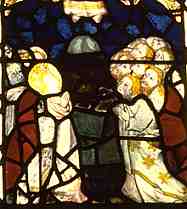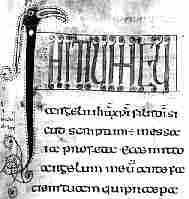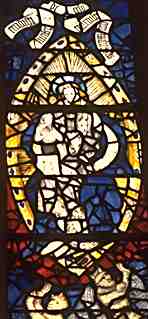 |
|
The
Bible |
|
The
fundamental literature of medieval Christianity was the Bible,
the Old Testament
comprising the books of the history of the Jewish people in the period
before Christ's birth and the New
Testament telling the life, death and resurrection of Christ and the
subsequent works of the apostles and early converts. Until around the
4th century AD, the Bible was the only formal liturgical
book in use in the Christian church. |
|
|
A
Biblical scene depicted in stained glass in the church of All Saints,
Pavement, York. The apostles watch Christ ascend to heaven, his feet dangling
from the sky while his footprints remain on the hill top. It is included
here simply because I like it so much. |
|
The
general form and content of the Bible had been established in the early
centuries of Christianity. The medieval Bible of the Western or Roman
church was in Latin, the Vulgate
version as translated and revised by St Jerome in the late 4th and early
5th centuries. As various Latin versions of the Bible had been in circulation,
Jerome translated his versions anew. The Gospels were translated from Greek sources, while the complete Old Testament was
translated from the Hebrew. |
|
Until
around the 12th century there were few complete Bibles. Various segments
of the Bible were reproduced as separate volumes. Some of the most famous
early manuscripts are Gospels, containing only the accounts of the life
of Christ, the books of Matthew, Mark, Luke and John. |
|
|
Section
of a page from an early 8th century Gospel, probably written at Lindsifarne
(British Library, Royal 1 B VII, f.56), by permission of the British Library. |
| The above example was probably more of a working service book and less of a display volume than the more famous Lindisfarne Gospels. |
|
Other
segments produced individually included the Acts of the Apostles and the
Psalms. The Book of Revelations, when produced on its own as a volume,
was termed an Apocalypse.
The wild imagery from the Book of Revelations lent itself to depiction
in amazing miniatures. |
|
 |
|
Apocalyptic
visions from an early 13th century volume (Cambridge, Trinity College
Library, MS R 16.2, f.14). |
|
|
|
The
woman clothed with the sun, with the moon under her feet and a crown of
stars, who travailed and brought forth a man child, is one of the visual
wonders of Revelations depicted in the windows of St Michael Spurriergate
church in York. |
|
The
various books of the Old Testament were produced individually, or several
together. The first five books of the Bible in a single volume, for example,
was known as the Pentateuch. |
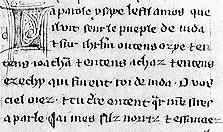 |
Various
books of the Bible had been produced in Old
English in late Anglo-Saxon England, but the use of Latin was restored
under the combined effects of 10th century reforms and the Norman Conquest.
Paraphrases or metrical verse versions of certain books of the Bible were
produced in the vernacular,
in French or English, from the 13th century. |
|
Segment
from a French Bible Historiale of the early 14th century (British Library,
Royal MS I A xx, f.66). |
|
In
the 14th century the so-called Wycliffite translations into English appeared
in the form of a plain translation which was comprehensible to the laity.
In an imposition of church authority against the Lollard heresy, the use
of these was forbidden in the early 15th century. As the majority of the
population was not competent in Latin, the original source material of
Christian teaching was only truly accessible to the educated clergy, who
interpreted it for the people through preaching and lessons. |
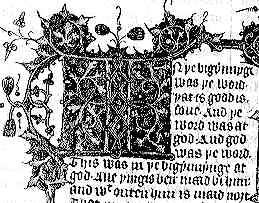
Section
from a Wycliffite Bible.
|
|
Up
into the 12th century Bibles, or the components thereof, were large and
imposing volumes, often grandly decorated, designed for liturgical use.
They sat on a lectern and were used for readings in church, as objects
of public performance. The reproduction of these works by manual copying
was undertaken in monastic scriptoria.
Sometimes the basic text had an accompanying commentary, known as a gloss,
built into the design of each page. Such weighty works were often divided
into several volumes.
|
|
In
the 13th century there was a great proliferation of small, portable Bibles
produced by commercial manuscript copyists rather than by monks. These
were the first Bibles to be systematically set out with books in a standard
format and with the text divided into numbered chapters. The Gothic
script of these volumes was tiny, simplified and neat. |
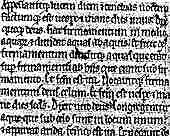 |
The
minute compressed script of a 13th century Bible (British Library, Burney
MS 3). |
|
In
the 14th and 15th centuries these were overtaken in production again by
large Bibles designed for public use in church; weighty and significant
ritual objects in their own right. By the late 15th century these could
be reproduced by the printing process and were one of the first works
in production.
|
|
Early
Bibles and Gospels  |
|
Great
Big Bibles  |
|
Little
Tiny Bibles  |
|
Vernacular
Bibles  |
|
 Categories
of Works Categories
of Works
|
|
 |
 |
 |
 |
 |
 |
 |
